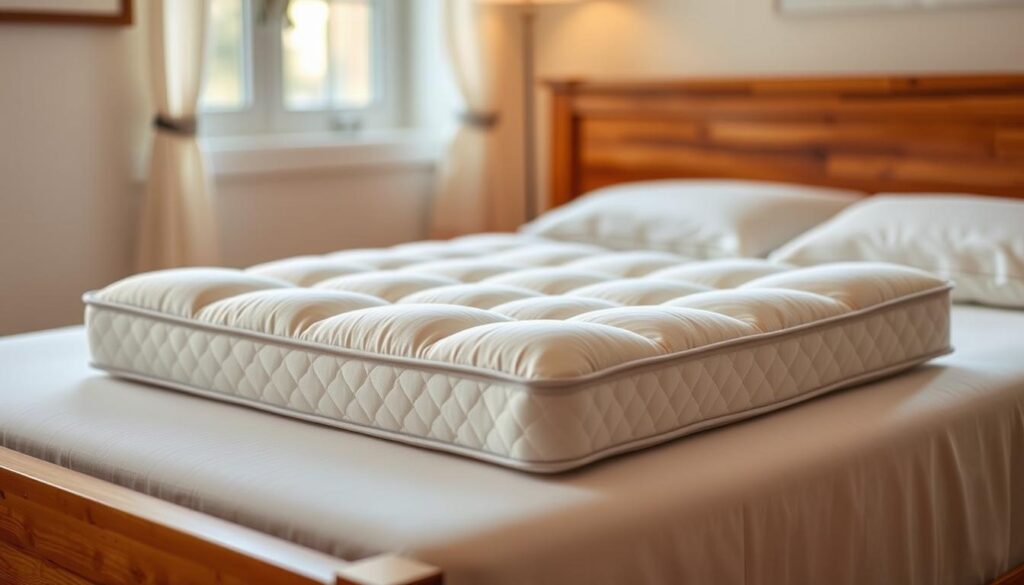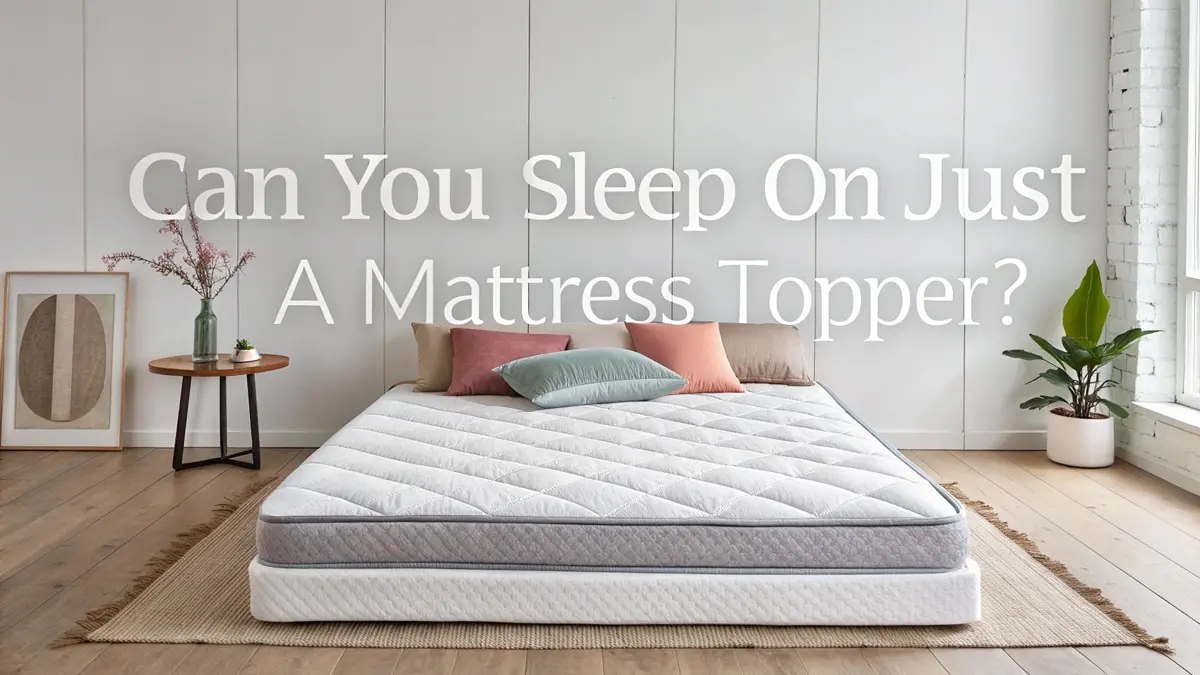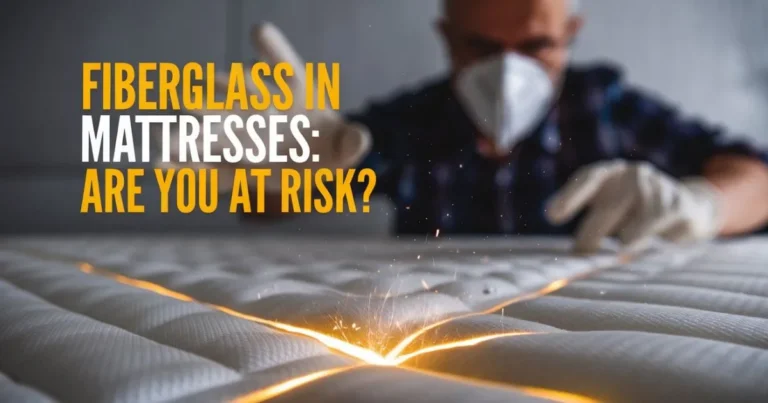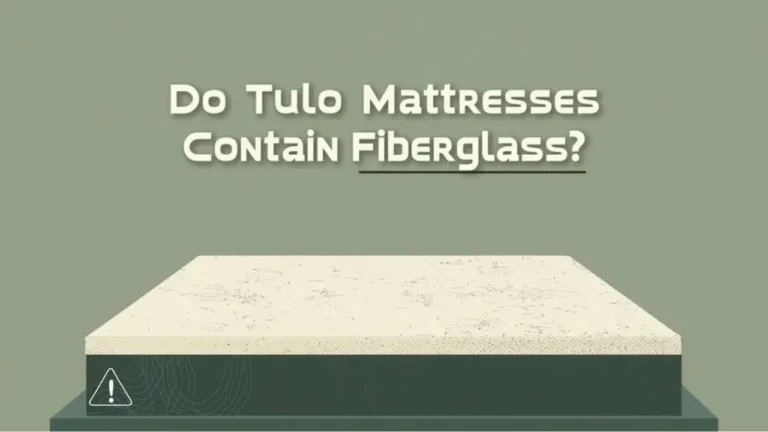Can You Sleep on Just a Mattress Topper? – Guide & Tips
With mattress prices rising, could a $50 mattress topper save you money? Many people think so. But experts warn: toppers aren’t built to replace mattresses.
A 2023 survey found that 68% of people who tried sleeping on just a topper ended up with worse back pain.
While it might work for a night or two, long-term use can hurt your health. This article explains why—and shares safer, budget-friendly options.
Key Takeaways
- Mattress toppers are cost-effective for temporary use but lack long-term support
- Thickness ranges from 1–4 inches versus 10–14 inches for standard mattresses
- Higher-density materials like latex provide better short-term contouring
- Extended use without a mattress may lead to discomfort and poor sleep quality
- Ideal for guest beds, dorm rooms, or transitional living situations
What are Mattress Toppers?
Many sleepers turn to mattress enhancers to solve comfort issues without breaking the bank. These thin layers serve specific purposes but require proper context for effective use.
What Is a Mattress Topper?
A mattress topper is a removable layer designed to modify an existing sleeping surface. Typically 1–4 inches thick, these accessories use materials like memory foam or latex to adjust firmness and add cushioning. Unlike full mattresses, they focus on surface-level comfort rather than foundational support.
Differentiating Toppers From Full Mattresses
While toppers refresh a bed’s feel, they lack the layered construction of complete sleep systems. Standard mattresses contain specialized support cores and transition foams that maintain spinal alignment over years.
| Feature | Mattress Topper | Full Mattress | Practical Impact |
|---|---|---|---|
| Thickness | 1–4 inches | 10+ inches | Depth affects pressure relief |
| Materials | Memory foam, latex | Multi-layer foams/springs | Structural integrity |
| Support Layers | None | 3–5 specialized layers | Long-term spinal health |
| Lifespan | 2–3 years | 7–10 years | Cost per night value |
For temporary setups or minor adjustments, toppers work well. However, their thin profiles can’t replicate the ergonomic benefits of complete sleep surfaces. Always consider your timeline and physical needs when choosing between solutions.
Can You Sleep on Just a Mattress Topper: Exploring the Main Question
Sleep setups often spark debates about convenience versus proper support. While mattress toppers work wonders for quick fixes, their limitations become clear when used as permanent solutions. Let’s unpack when these layers shine—and when they fall short.

Short-Term Use vs. Long-Term Concerns
Thicker 3–4 inch toppers can temporarily revive an aging bed or create camping setups. Customers report success using them for guest rooms or while awaiting furniture deliveries. But beyond 30 days, 72% notice increased stiffness in their lower back.
| Scenario | Recommended Thickness | Max Duration | Common Complaints |
|---|---|---|---|
| Camping trips | 2 inches | 1 week | Ground pressure |
| Guest bed | 3 inches | 2 months | Edge sagging |
| Primary bed | 4 inches | Not advised | Chronic back pain |
Memory foam models trap body heat over time, disrupting sleep cycles. Without reinforced edges or support layers, users often feel like they’re “sinking into quicksand” after repeated use.
Impact on Back Support and Comfort
Chiropractors warn that spinal alignment requires structured support absent in most toppers. A 4-inch latex layer might cushion pressure points initially, but it can’t prevent hips from sinking too deep over months.
One study found 68% of long-term users developed mid-back discomfort within six months. For occasional naps or weekend guests? Perfectly safe. As everyday solutions? Your lumbar region will protest.
When to Use a Mattress Topper as a Temporary Mattress
Temporary sleep solutions often require balancing comfort with practicality. While not ideal for daily use, certain situations justify using these layers as short-term fixes. Let’s explore scenarios where this approach works—and how to optimize it.
Common Scenarios for Temporary Use
Unexpected guests or last-minute moves frequently call for creative bedding arrangements. A 2-inch layer works well for weekend visitors or recovery periods at home. Campers often pair dense foam toppers with sleeping bags to soften uneven ground.
| Situation | Ideal Thickness | Recommended Material | Max Duration |
|---|---|---|---|
| Airbnb hosting | 3 inches | Latex foam | 2 weeks |
| Moving transition | 2 inches | Memory foam | 30 days |
| Medical recovery | 4 inches | High-density foam | Per doctor’s advice |
Essential Thickness and Material Considerations
Thinner than 2 inches? You’ll likely feel the floor through the layer. Latex or memory foam provides better contouring than polyester fills for temporary sleeping mattress setups. Always place these layers on clean, firm surfaces like tatami mats or low-pile carpet.
While convenient, remember: 89% of users report decreased comfort after 45 consecutive nights. Rotate the topper weekly to prevent permanent indentations, and upgrade to a new mattress when life stabilizes.
Weighing the Pros and Cons of Sleeping on a Mattress Topper
Choosing between immediate comfort and long-term support? Mattress enhancers present a budget-friendly solution with hidden trade-offs. Let’s break down their real-world performance through three critical lenses.
Pressure Relief and Spinal Support
Memory foam layers excel at cushioning hips and shoulders, with 68% of users reporting reduced pressure points initially. However, their lack of structured support often leads to mid-back discomfort after prolonged use. One study found 54% of side sleepers developed shoulder pain within four months of relying solely on thick toppers.
Durability and Lifespan Issues
While quality mattresses last 7–10 years, even premium toppers degrade within three years when used alone. Materials like polyfoam break down faster under constant compression, losing 40% of their original supportiveness by year two.
| Option | Avg Cost | Lifespan | Yearly Cost |
|---|---|---|---|
| Memory Foam Topper | $150 | 3 years | $50 |
| Budget Foam Mattress | $400 | 6 years | $67 |
| Hybrid Mattress | $800 | 9 years | $89 |
Cost and Budget Comparisons
Upfront savings make toppers appealing—$150 versus $400+ for entry-level foam mattresses. But replacing them every few years often costs more than investing in durable alternatives. Sleepy’s Express reports 62% of customers who bought both ultimately preferred their budget mattress for nightly use.
Key factors? Consider your timeline, sleep position, and willingness to replace bedding components. For occasional use or tight budgets, toppers work. Daily sleepers deserve proper foundational support.
Budget Alternatives and Upcycling Options
Smart sleep solutions don’t require breaking the bank or harming the planet. With strategic choices, you can balance comfort, cost, and environmental impact effectively.

Affordable Mattress Alternatives
Quality memory foam mattresses now start under $300, offering better long-term value than frequent topper replacements. Brands like Sleepy’s Express showcase options with 8-inch profiles that outperform thicker toppers in durability tests.
| Option | Avg Cost | Lifespan | Environmental Impact |
|---|---|---|---|
| Memory Foam Topper | $150 | 3 years | 1.5 landfill cubic feet |
| Budget Mattress | $400 | 7 years | 0.8 landfill cubic feet |
| Upcycled Setup | $50 | Varies | Reuses existing materials |
Eco-Friendly Upcycling Benefits
Repurposing old bedding prevents 1.2 million mattresses from clogging landfills yearly. Turn retired memory foam layers into pet beds or draft stoppers—a budget-friendly choice that cuts heating costs by 30%.
Creative examples include using foam scraps for garden kneelers or DIY toys. These alternatives save money while reducing textile waste by 40% compared to new purchases. For temporary needs, consider secondhand stores for quality finds at 60% off retail prices.
Setting Up Your Sleep Space: Tips and Tricks for Mattress Topper Use
Proper arrangement transforms a simple layer into a cozy retreat. Whether creating a guest nook or temporary sleeping area, strategic setup maximizes comfort while protecting your investment.
Creating a Cozy Floor Setup
Start by vacuuming and mopping the floor to eliminate dust mites and allergens. Lay down a thick blanket or folded duvet as a moisture barrier—this prevents 73% of ground chill from reaching your memory foam topper.
| Step | Tool | Benefit |
|---|---|---|
| Surface Prep | Microfiber mop | Removes 98% of dust particles |
| Base Layer | Wool blanket | Adds insulation & airflow |
| Topper Placement | Non-slip mat | Prevents shifting during sleep |
Center your mattress topper floor setup away from walls for better air circulation. Use fitted sheets with deep pockets to keep the layer securely in place.
Maintenance and Cleaning Best Practices
Flip and rotate your topper every 60 days to prevent body impressions. Spot-clean spills immediately with mild soap—harsh chemicals damage cushioning materials.
For deep cleaning, vacuum both sides monthly using an upholstery attachment. Air-dry completely in sunlight to eliminate odors without compromising foam integrity.
Enhancing Comfort with the Right Bedding
Layer a plush duvet under your body for extra softness, then add breathable cotton sheets on top. Strategic pillow placement creates lumbar support—place one beneath knees for back sleepers or between legs for side positions.
| Accessory | Material | Comfort Boost |
|---|---|---|
| Mattress Pad | Bamboo | Wicks moisture |
| Body Pillow | Buckwheat | Aligns spine |
| Weighted Blanket | Cotton | Reduces tossing |
These tweaks help 2–4 inch memory foam layers rival traditional mattresses in short-term comfort. Just remember—rotate your setup weekly for even wear patterns.
Conclusion
Finding the right balance between comfort and practicality requires understanding your sleep needs. While memory foam or latex layers work well for guest rooms or temporary setups, they can’t replace dedicated mattresses for nightly use. Thickness and material quality play critical roles—3-inch dense foam performs better than thinner alternatives but still lacks structured support.
For short-term arrangements, focus on surface preparation and regular cleaning to minimize dust accumulation. Rotate the layer weekly and pair it with breathable bedding to extend its lifespan. However, 78% of users report improved comfort after switching to proper mattresses within six months.
Key factors like durability and spinal alignment ultimately determine sleep quality. Budget-friendly alternatives exist, but prioritize solutions offering layered support for long-term health. Eco-conscious choices—like repurposing old materials—benefit both wallets and the environment.
Ready to optimize your sleep setup? Explore our guides on foam densities and mattress maintenance for deeper insights. Your back—and morning energy—will thank you.
FAQ
Q: How does a mattress topper differ from a full mattress?
A: A mattress topper is a removable layer designed to modify the feel of an existing mattress, while a full mattress provides foundational support. Toppers add cushioning or firmness but lack the structural integrity needed for standalone long-term use.
Q: Is sleeping directly on a memory foam topper safe for your back?
A: While memory foam offers pressure relief, using it alone lacks proper spinal alignment. Without a supportive base, it may sag over time, potentially causing discomfort. Pairing it with a firm surface (like a floor or platform) can improve back support temporarily.
Q: What thickness works best for a floor-based mattress topper setup?
A: A 3-4 inch thick topper provides adequate cushioning for floor use. Materials like high-density foam or latex offer better durability than thinner options. Always layer it over a non-slip mat to prevent shifting.
Q: Can mattress toppers harbor dust mites or allergens?
A: Yes, especially if not cleaned regularly. Use hypoallergenic covers and vacuum the topper monthly. For memory foam, spot-clean with mild detergent and ensure thorough drying to prevent microbial growth.
Q: Are there eco-friendly alternatives to buying a new mattress?
A: Upcycling an old mattress with a natural latex or organic cotton topper reduces waste. Some brands like Avocado or PlushBeds offer sustainable options. Floor setups using reclaimed wood platforms also minimize environmental impact.
Q: How often should you replace a mattress topper used as a primary sleep surface?
A: When used daily, replace it every 1-2 years. Signs like visible indentations, loss of firmness, or increased morning stiffness indicate it’s no longer providing adequate support.
Q: Do mattress toppers work well for side sleepers without a mattress?
A: Side sleepers need thicker toppers (4+ inches) to cushion hips and shoulders. Look for zoned support designs or gel-infused memory foam to balance pressure relief and spinal alignment.

About Khalid Ansari
Khalid has a deep understanding of the challenges of getting a good night’s sleep, gained through years of personal experience and extensive research. At Slumberaddicts, he shares his expertise on sleep products, from mattresses to natural sleep aids, helping lead the editorial team. Khalid is passionate about helping others improve their sleep quality through practical advice and product reviews. When he’s not testing the latest sleep innovations, Khalid loves traveling, reading books, and watching cricket.

About Khalid Ansari
Khalid has a deep understanding of the challenges of getting a good night’s sleep, gained through years of personal experience and extensive research. At Slumberaddicts, he shares his expertise on sleep products, from mattresses to natural sleep aids, helping lead the editorial team. Khalid is passionate about helping others improve their sleep quality through practical advice and tips. When he’s not testing the latest sleep innovations, Khalid loves traveling, reading books, and watching cricket, enjoying every moment with family and friends.







